Top Rankings
Russellville City School District ranks among the top 20% of public school district in Alabama for:
Category
Attribute
Graduation Rate
Highest graduation rate (Top 5%)
For the 2025 school year, there is 1 public middle school serving 591 students in Russellville City School District. This district's average middle testing ranking is 6/10, which is in the top 50% of public middle schools in Alabama.
Public Middle School in Russellville City School District have an average math proficiency score of 24% (versus the Alabama public middle school average of 21%), and reading proficiency score of 43% (versus the 46% statewide average).
Minority enrollment is 69% of the student body (majority Hispanic), which is more than the Alabama public middle school average of 45% (majority Black).
Overview
This School District
This State (AL)
# Schools
5 Schools
534 Schools
# Students
2,608 Students
236,737 Students
# Teachers
157 Teachers
12,843 Teachers
Student : Teacher Ratio
17:1
17:1
District Rank
Russellville City School District, which is ranked within the top 50% of all 145 school districts in Alabama (based off of combined math and reading proficiency testing data) for the 2021-2022 school year.
The school district's graduation rate of 95% has stayed relatively flat over five school years.
Overall District Rank
#64 out of 145 school districts
(Top 50%)
(Top 50%)
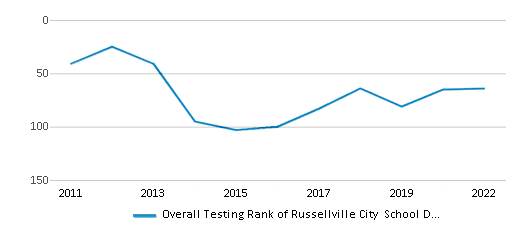
Math Test Scores (% Proficient)
31%
29%
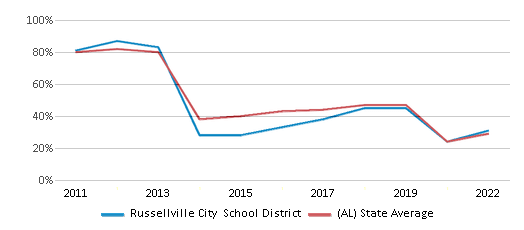
Reading/Language Arts Test Scores (% Proficient)
43%
47%
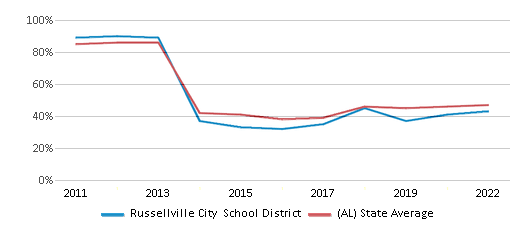
Science Test Scores (% Proficient)
42%
38%

Graduation Rate
≥95%
88%

Students by Ethnicity:
Diversity Score
0.55
0.61
# American Indian Students
16 Students
3,329 Students
% American Indian Students
1%
2%
# Asian Students
11 Students
2,720 Students
% Asian Students
n/a
1%
# Hispanic Students
1,545 Students
24,370 Students
% Hispanic Students
59%
10%
# Black Students
118 Students
68,686 Students
% Black Students
5%
29%
# White Students
852 Students
129,762 Students
% White Students
33%
55%
# Hawaiian Students
1 Student
257 Students
% Hawaiian Students
n/a
n/a
# Two or more races Students
65 Students
7,613 Students
% of Two or more races Students
2%
3%
Students by Grade:
# Students in PK Grade:
80
2,540
# Students in K Grade:
199
5,092
# Students in 1st Grade:
220
5,246
# Students in 2nd Grade:
188
5,239
# Students in 3rd Grade:
188
5,011
# Students in 4th Grade:
185
5,480
# Students in 5th Grade:
180
10,423
# Students in 6th Grade:
198
39,140
# Students in 7th Grade:
208
55,757
# Students in 8th Grade:
185
56,367
# Students in 9th Grade:
193
13,737
# Students in 10th Grade:
190
11,591
# Students in 11th Grade:
184
10,975
# Students in 12th Grade:
210
10,139
# Ungraded Students:
-
-
District Revenue and Spending
The revenue/student of $13,722 is higher than the state median of $13,006. The school district revenue/student has stayed relatively flat over four school years.
The school district's spending/student of $15,268 is higher than the state median of $12,220. The school district spending/student has stayed relatively flat over four school years.
Total Revenue
$36 MM
$9,671 MM
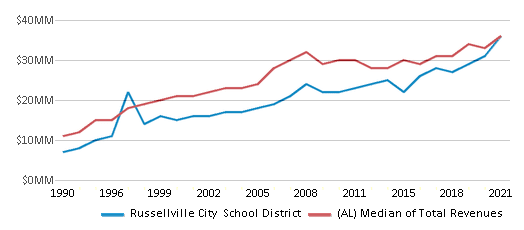
Spending
$40 MM
$9,086 MM
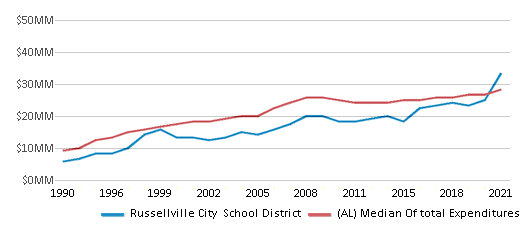
Revenue / Student
$13,722
$13,006
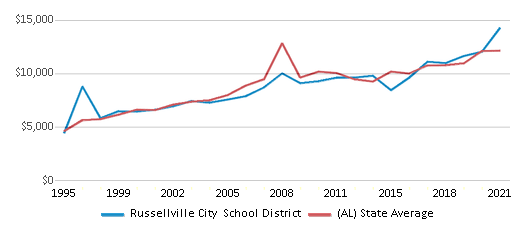
Spending / Student
$15,268
$12,220

Best Russellville City School District Public Middle Schools (2025)
School
(Math and Reading Proficiency)
(Math and Reading Proficiency)
Location
Grades
Students
Rank: #11.
Russellville Middle School
(Math: 24% | Reading: 43%)
Rank:
Rank:
6/
Top 50%10
765 Summit St
Russellville, AL 35653
(256) 331-2120
Russellville, AL 35653
(256) 331-2120
Grades: 6-8
| 591 students
Recent Articles

Year-Round Or Traditional Schedule?
Which is more appropriate for your child? A year-round attendance schedule or traditional schedule? We look at the pros and cons.

Why You Should Encourage Your Child to Join a Sports Team
Participating in team sports has a great many benefits for children, there is no doubt. In this article you will learn what those benefits are.

White Students are Now the Minority in U.S. Public Schools
Increasing birth rates among immigrant families from Asia and Central and South America, combined with lower birth rates among white families, means that for the first time in history, public school students in the United States are majority-minority. This shift in demographics poses difficulties for schools as they work to accommodate children of varying language abilities and socio-economic backgrounds.





